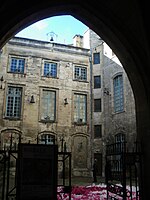Palais des Papes

The Palais des Papes (English: Palace of the Popes; lo Palais dei Papas in Occitan) is a historical palace located in Avignon, Southern France. It is one of the largest and most important medieval Gothic buildings in Europe. Once a fortress and palace, the papal residence was a seat of Western Christianity during the 14th century. Six papal conclaves were held in the Palais, leading to the elections of Benedict XII in 1334, Clement VI in 1342, Innocent VI in 1352, Urban V in 1362, Gregory XI in 1370 and Benedict XIII in 1394. Since 1995, the Palais des Papes has been classified, along with the historic center of Avignon, as a UNESCO World Heritage Site, for its outstanding architecture and historical importance for the papacy.
Excerpt from the Wikipedia article Palais des Papes (License: CC BY-SA 3.0, Authors, Images).Palais des Papes
Rue de Taulignan, Avignon Quartier Centre
Geographical coordinates (GPS) Address Website External links Nearby Places Show on map
Geographical coordinates (GPS)
| Latitude | Longitude |
|---|---|
| N 43.9508 ° | E 4.8075 ° |
Address
Palais des Papes
Rue de Taulignan
84000 Avignon, Quartier Centre
Provence-Alpes-Côte d'Azur, France
Open on Google Maps










